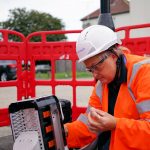UPD BT Criticised as Scottish Rural Action Seeks Better Broadband Policy
The non-profit Scottish Rural Action group has published a new report that points to “serious failings” in Scotland’s existing roll-out of “superfast broadband” services with BT and calls for 5 major policy changes, which they say would establish an “ultrafast” (300Mbps+) model for rural areas.
At present the £410m Digital Scotland project with Openreach (BT) has already made its FTTC/P based “fibre broadband” network available to 85% of premises in Scotland and they’re now working towards the next goal of 95% by December 2017, although the more rural Highland and Islands (HIE) region alone currently only expects to hit 84% by the end of this year.
Advertisement
A recent report from Audit Scotland (here) appeared to confirm that “good progress” was being made, although it also said that there was still a lot more work to do “particularly in improving download speeds in rural areas.” On top of that they highlighted the need for a “clear plan” to boost take-up and deliver on the new pledge for 100% coverage by 2021.
By comparison SRA’s new report (PDF) is somewhat less forgiving and accuses BT of using the strategy to “prop up its decaying copper network” and of “reducing its expenditure on duct with the result that the net value of its asset base is beginning to decrease.” Furthermore it claims that faults on BT’s network have increased due to the “redirection of resources to the NGA rollout.”
SRA Report Statement
This is the time to accept that BT has misjudged its strategy and that copper-reliant technology will no longer meet the needs of Scottish rural communities.
Fibre to the Cabinet [FTTC] is an inefficient methodology in rural communities and the red herring of VDSL is fit only to provide BT with a way to continue to leverage its monopoly of copper exchange lines.
Rural Scotland’s economy will face many challenges in the next few years and there is uncertainty over future business support, especially in the agricultural sector and in rural development post-Brexit.
The Scottish Government needs to ensure that rural connectivity is not an additional challenge, by establishing an ultrafast model (defined by Ofcom as more than 300 Mbps) for the most remote and rural areas, supporting real futureproof networks so that the rural area will not be marginalised again in 10 years, by which time all applications will be designed for hyper networks.
Apparently the report was collated by the SRA’s working group, consisting of more than 30 individuals and community groups, who are all said to be “working hard on a voluntary basis to deliver this essential service to their locality.”
“They feel strongly that the systems need to change if we are ever going to see equity between rural and urban communities and delivery of the Scottish Government’s commitment to superfast broadband to 100% of premises in Scotland,” said Amanda Burgauer, Chair of the SRA.
Advertisement
In keeping with that the SRA’s Broadband Working Group has proposed five recommendations, which it believes would help to improve rural connectivity in Scotland.
The Five SRA Recommendations
1. The Scottish Government should redirect resources to quickly facilitate the provision of community/national backhaul, local backbone networks and community hubs to support access networks. This will prime the pump for Internet Service Providers to provide connectivity either commercially or through community projects, possibly including State Aid-funded projects.
2. The Scottish Government, having made the commitment to reach 100 per cent super-fast coverage, should accept that this is a stepping stone to ultra-fast speeds and ensure that there are clear upgrade paths available to all rural networks.
3. Rural communities should be supported through access to specialist advice according to their needs. This might include business planning, technical advice, help with funding, legal guidance regarding way leaves and other support. There needs to be a mechanism for accessing this support and sharing knowledge amongst community projects in a collaborative way, and not through the current Community Broadband Scotland approach, which has blocked many projects rather than facilitate them.
4. Existing rural broadband and rural initiatives and resources should be coordinated to best respond to rural broadband requirements and overcome obstacles that currently impede rural broadband deployment. These should be addressed and managed by the team responsible for reaching 100 per cent, as a singly managed project, with clear accountability for delivery.
5. There should be a Scottish Broadband Conference, using an Open Space-type of facilitation, that brings together all stakeholders, including Scottish Government, community projects, network providers and suppliers, to evaluate the status quo and share views and solutions.
Some of the suggestions, such as to help provide rural communities with more support (no.3), to establish more coordination (no. 4) and setting up a meeting between all of the stakeholders (no.5), seem to be fairly logical.
Likewise the idea of encouraging the Scottish Government to start thinking about “ultra-fast” connectivity (no.2) would actually be in keeping with the current direction of travel within the EU. Even the UK Government has quietly begun to talk about it (here), although we’re admittedly still a very long way away from seeing a firm strategy.
However the issue of backhaul (no.1) is more complex and the recommendation isn’t entirely clear about its idea for “community hubs to support access networks.” In some ways this issue is already being tackled by Ofcom’s move to free up access to BT’s Cable Ducts / Poles (DPA) and their Dark Fibre Access (DFA) measures, although funding and building any new backhaul network for rural areas will always be difficult due to the challenge of getting a return on such investments.
Advertisement
Never the less, supplying capacity to remote rural networks is a big part of the battle, but the situation is improving and today there are many more methods (inc. Microwave) for getting capacity to such locations. Whether or not new backhaul links should also be built and managed by the state is an altogether more complicated question and one that Ofcom would perhaps need to consider. If it were to happen then there would need to be strict rules to help tackle any competition issues.
UPDATE 6:32pm
BT has given us the following statement.
A BT Spokesperson told ISPreview.co.uk:
“We’re pleased that the Scottish Rural Action report into broadband has recognised that BT’s approach of using a mix of technologies to reach the greatest number of people possible and is on track to provide more than 95 per cent superfast broadband coverage in Scotland by the end of the Digital Scotland superfast Broadband programme. Audit Scotland confirmed this in their recent review of the project.
Today, more than two million Scottish homes and businesses can order fibre broadband. On speeds, more than 85 per cent of households in Scotland are able to access superfast broadband speeds in excess of 30Mbps, according to the independent website Think broadband.
Across rural Scotland, fibre networks over land and sea have helped many locations to benefit, including Shetland, Perthshire and the Scottish Borders, for example, with more to come. In the Highlands and Islands, more than 188,000 premises can now benefit from faster fibre broadband.
BT has invested more than £1bn a year in Openreach, including more than £3bn in rolling out superfast broadband across the UK.
BT continues to invest in new, innovative technologies to reach more people, including the long-reach VDSL trial in North Tolsta, in the Western Isles.
Openreach will be deploying more FTTP in the coming years but it is important to note that it is only one technology amongst many and that other technologies can also deliver ultrafast speeds.
Countries such as Australia are following the UK’s lead in terms of deploying a mix of technologies. This approach helps to ensure a rapid deployment as well as low prices for consumers and businesses.
On service, while Openreach continues to meet or exceed the 60 performance targets set by Ofcom, we realise there is more to do and customer service remains a priority. Hundreds of engineers have been recruited across Scotland and we are fixing repairs and installing new lines quicker than before.”
Mark is a professional technology writer, IT consultant and computer engineer from Dorset (England), he also founded ISPreview in 1999 and enjoys analysing the latest telecoms and broadband developments. Find me on X (Twitter), Mastodon, Facebook, BlueSky, Threads.net and Linkedin.
« 4G Mobile Upgrade Finally Coming to Virgin Media in October 2016
UK ISP BT Slashes Unlimited Broadband and Fibre FTTC Prices »


















































Comments are closed